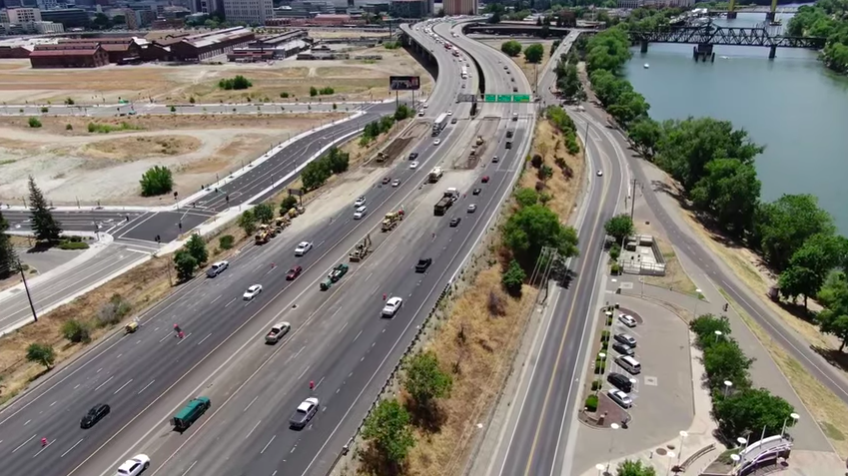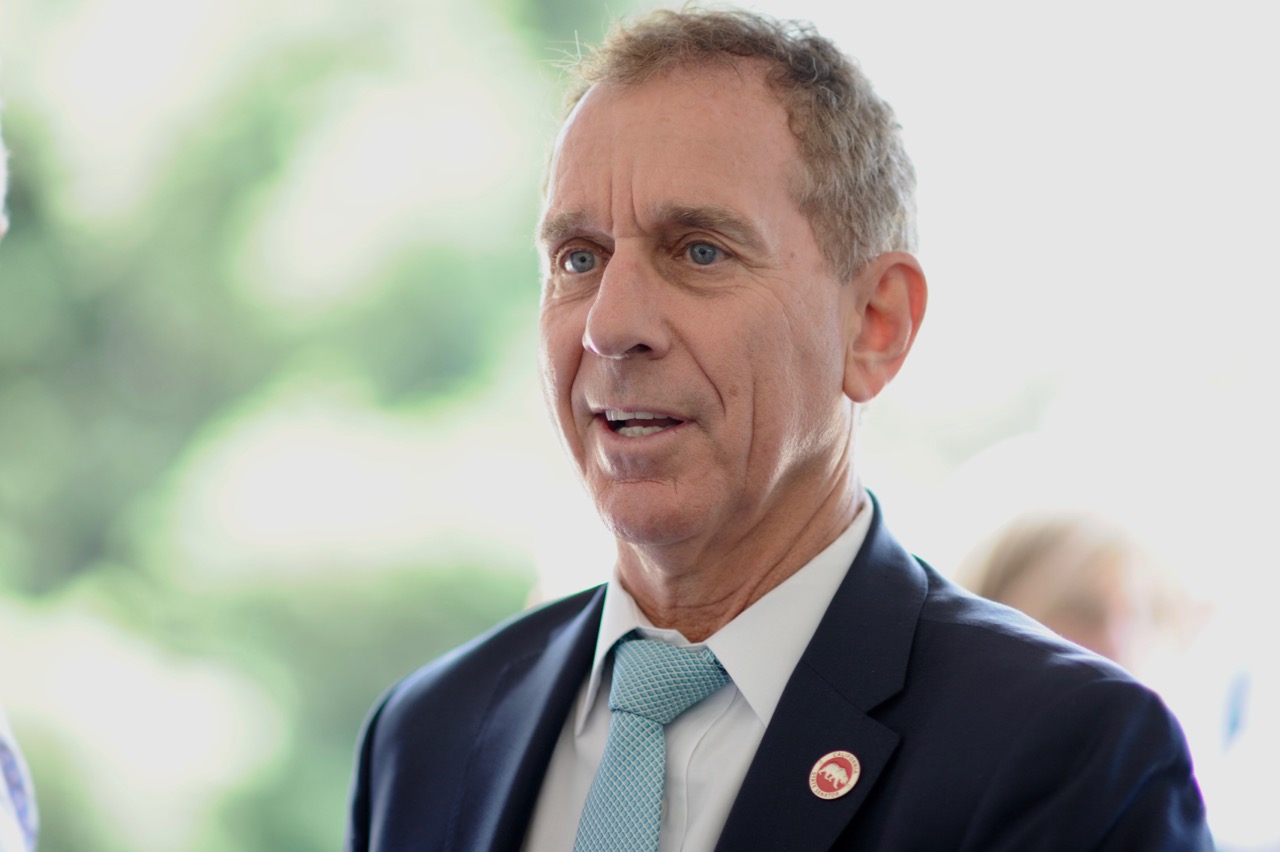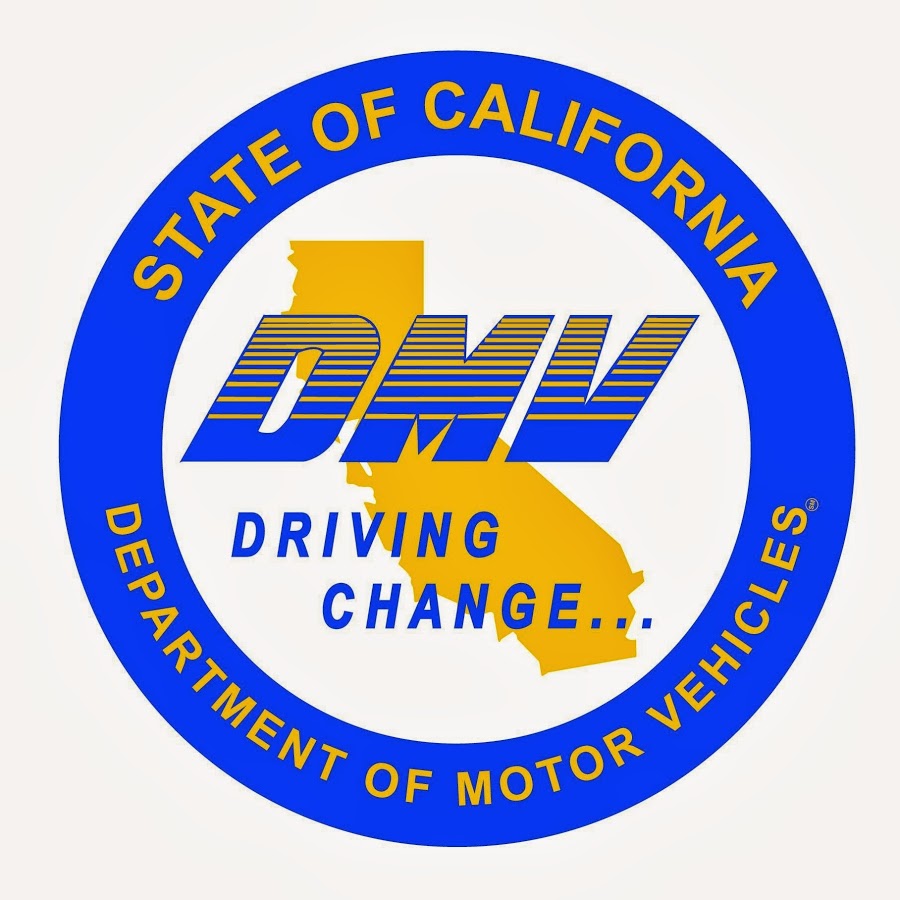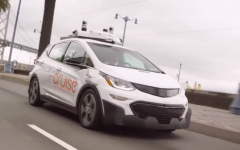
I-5 in Sacramento. (Photo: youtube screen capture)
A Primer on Vehicle-Miles-Traveled Taxation Concepts
How any VMT would be actually charged is not yet determined
By Thomas Buckley, November 10, 2021 2:23 am
For some years the idea of replacing the pay-at-the-pump gas tax with a “vehicle miles traveled” system has been floating in the civic ether. The reasoning took a few different paths, mostly centered around the issue of the fairness of “user fees” compared to purchase taxation, an idea that was boosted by the proliferation of non-gas using vehicles like electric cars (why am I paying gas taxes for the roads when the Tesla driver pays nothing?, etc.)
A very few states have already and/or are conducting pilot programs to test the idea and California and the federal government are in the process of evaluating how a VMT tax would work.
The first state to dip its toe in the gas pool was Oregon, which signed up about 700 people who tracked their mileage and then submitted the records to the state for reconciliation. Oregon declared the effort a success (though it should be noted the participants were highly-motivated volunteers) and is now moving forward on the possibility of a mandatory program.
As this issue will be definitely coming to the fore very shortly, we’ve put together a primer on the terms and concepts that will be bandied about in the coming months and years. (Please note – we hope not to get as far into the weeds as a Mendocino County national forest and the impacts may be larger than they appear in the mirror).
Basically, a VMT would be just that – a tax based on how many miles a vehicle moves over the roadways instead of paying a tax every time the gas tank is filled. Proponents say it is intended to be “cost neutral” for the typical driver.
For example, right now – and these are general AVERAGES – Californians drive each personal car about 13,000 miles per year. At a miles per gallon figure of 25, that means that – at $1.19 per gallon (the state, fed, sales tax plus fees like cap and trade total) – a typical motorist will pay $618 per year, or 4.8 cents a mile, in taxes (again these are averages of typical personal vehicle and do not reflect trucks, commercial vehicles, taxis, the use of diesel fuels, etc.). Most VMT concepts so far have floated a per-mile number in that range as their target.
That is the basic top-line proposal – but exactly how it would work has as many possible twists and turns and off-ramps and on-ramps and side streets as the Orange Crush in southern California being combined with Lombard Street in San Francisco.
There are five basic ways the fee could be calculated:
- Straight miles – turn the car on, drive 10 miles – no matter where or when – and pay 10 miles in taxes.
- Highway/major artery miles – no (or a lower) fee for driving around town but the tax would start when one entered a freeway and/or major artery (think Wilshire Boulevard).
- Congestion miles – a lower tax on any driving during “off-peak” hours, but miles driven during typically heavy traffic times for that specific roadway would be taxed (think the toll lanes in Orange County).
- Time miles – Similar to congestion miles, but not tied to specific traffic patterns, just the time (and not necessarily the amount of time) of the beginning and/or end of the trip – middle of the night low or no tax, mornings a tax, etc.
- Cordon miles – Driving in certain areas and/or on certain roads would be taxed while driving elsewhere would not, or be taxed less (this could also be done not just by the mile but also an added tax/fee upon entering a particular area).
In theory, the following taxing scenario could occur on a drive from San Juan Capistrano to Burbank.
Under “miles only,” it would be about 70 miles of tax and that would be that.
Under highway/arterial miles, it would be the miles you drove on the 405, etc., plus the miles on Jamboree if you happened to get off the freeway to visit someone for lunch along the way. Congestion and/or time miles would be relatively similar, but the tax rate could vary depending upon when you take the trip.
How cordon mile pricing works is rather intricate. Under a VMT system, a government agency (local, state and/or federal) would pre-determine which areas – not specific roads – have the most problematic traffic and charge fees when the driver is in that neighborhood (akin to the charge – about $20 – drivers in London, England now must pay each time they cross the line into the hub of the city). As an example, on this particular trip the driver could pass through multiple high traffic density cordon areas – Irvine, Anaheim, downtown Los Angeles, and Burbank itself – and each time the car entered the area the tax would begin and then end when the car left the cordon (either as a one-time flat fee or based on the number of miles traveled with the area).
A major local difference between the flat cordon fees imposed in London and elsewhere (all heavy employment/commuter destination hubs) is the simple fact that – especially in southern California – there would be many different such areas. Much to the chagrin of public transit planners, the state is different in that there are multiple significant employment centers scattered about; basically in New York a large percentage of commuting is done from many different places all into one place – the city. That does not apply to much of California where commuter patterns are not so much “A to B” but from everywhere to anywhere, hence the need for multiple cordon areas.
And now for the first complicated part – each of these types of fees could stand alone or be combined in some fashion depending upon the system installed. For example, a distance plus cordon fee would result in a combination of actual miles traveled with where those miles were traveled; a distance plus time fee could mean that the driver is paying 2 cents a mile when they leave San Juan Capistrano and 4 cents when they arrive in Burbank, a miles plus congestion model could be based on which route is taken, etc.
As to cordon fees, they are usually justified not necessarily as an overall gas tax replacement but as a way to decrease traffic in highly congested areas and are the most likely “add-on” concept. Most – but not all – cordon proposals discussed so far exempt people who live in the area from paying the fee for that area.
And now for the second complicated part – how any VMT would be actually charged is not yet determined. As noted, the pilot programs have relied on highly-motivated volunteers self-reporting mileages – for any number of reasons it is highly improbable that such a system could work on any large scale as it would rely solely on the memory and honesty of the average taxpayer (not everyone is as scrupulous as a friend of mine who literally has decades – and, yes, for cars he hasn’t owned for years and years – worth of detailed maintenance/oil change/mileage notebooks in his garage).
Almost certainly the implementation would involve either a transponder in each vehicle or an app that drivers could download and sync to their car. Either system would track exactly where and when a car was driving and calculate the tax based on whichever fee structure(s) is being used. If a transponder is used, it would simply track the car moving while the smart phone app would, presumably, track the location of both the car and the specific driver.
Both the app and transponder solutions raise serious data privacy issues that even VMT proponents admit is a major stumbling block to eventual implementation, as the chances that a majority of the public will think that allowing the government to know exactly where they are at any given time is a good idea is slim. There have been various privacy protection proposals made, but, given the interconnected nature of society in general and the VMT concept specifically, it is not clear that any amount of assurance would be enough for the public.
In California, at least, there is the option of charging the fee when the vehicle is “smogged” because the mileage between tests is an exact number that does not have be closely tracked by the driver. The driver would then pay the tax all at once at that time to be able to “pass” the test and/or register the vehicle. As paying such a large chunk of money at one time is far more noticeable – and irritating – than paying it bits and pieces as the current gas tax allows, it is possible a monthly “subscription” account could be created for – and paid by – each driver and then reconciled at the appropriate juncture.
Beyond the personal liberty and the “being taxed for leaving your home” issues are the myriad ways the system, once in place, could be modified to benefit certain people, potentially negating its core concept of everyone paying their proper proportional part.
First, there is the income differential issue. Some concepts publicly – and many, many privately – envision a sliding scale component to the tax, meaning that lower-income residents would actually pay a smaller per mile fee. In other words, if a person receives Medi-Cal or SNAP, they could automatically qualify for smaller per mile charge or the system could simply compare vehicle registration information to state and/or federal tax return data to determine who gets the discount, etc. (and, yes, that could mean the DMV and the IRS would have to closely “cooperate”).
Other fee modifications – which could cause the concept to be viewed not strictly as a fair tax but as an attempt at leveraging the system to modify public behavior – could possibly include:
- Fuel efficiency – if it is decided to use the fee to encourage cars that use fewer fossil fuels, than a discount could be applied to cars that getter better mileage (although oddly that does not seem to be the current trend – in fact environmentalists have complained that making clean alternative energy vehicles pay the same as regular cars and trucks would hurt the environment by taking away the financial advantage of not having to worry about paying gasoline taxes).
- Age of vehicle – to weed out older, more polluting vehicles they could face a higher per mile tax.
- Single car discount – to encourage carpooling and just driving less in general, a household that has only one vehicle could pay a lower rate.
- Transit discount – a person who regularly uses public transit (say they have an annual bus pass, for example) could also see a different rate.
- Taxi rates – could vehicles that are used to transport other people and/or goods and services be taxed at a different rate?
- Government rates – would “public” vehicles, even though they are using – and having an impact on – the same roads as everyone else be exempted from any tax?
- High use rates – to discourage “over driving” – read long commutes – the rate could be a sliding one that charges more per mile the more you drive in total.
It should be noted that each of the above concepts would/could be applied to commercial vehicles and diesel trucks under different rate structures and accounting for other factors inherent to those types of uses.
The modifications do play into the very meaning of the VMT concept itself – is it simply a different way to collect the same amount of money or should it also be used to manage traffic itself? Clearly a straight miles tax would not do that, but any of the other – either stand-alone or add-on – options would open that possibility.
And now for the third complicated part – borders. If, for example, the tax at the pump is removed, how would out-of-state drivers be made to pay their “fair share?” If it is not removed, then how would be deducted against the total mileage fee for each California driver? Also – especially if the system opts out of any vehicle tracking system – how would the miles driven out-of-state by California-registered vehicles where the driver would be paying taxes at the pump be handled? Under the “pay at smog” idea, it could be similar to your annual federal tax filing and a “standard deduction” could be taken or a drive could itemize their non-California travel.
Except for Hawaii (and to a lesser extent Alaska), each state would have to address these issues independently and, presumably, come up with a relatively standard implementation formula. Or – as is being discussed in Washington, DC currently – simply not bother with state-by-state systems and implement the concept at a federal level to cover every vehicle equally.
A federal system would seem to solve certain problems associated with the VMT concept, including the ability to properly and accurately portion out the revenue shares (X percent for the feds, Y for the state, Z for any local taxes, etc.). The federal concept could also simplify the transponder issues by making such tracking devices mandatory, like seat belts for example, for all new cars.
The downsides to any federal effort are obvious, particularly the political firestorm that would erupt if and when it wound its way through Congress. The legality of a federal law is also in doubt, though this could be wiggled around in the same way the 55 mile-per-hour speed limit (and the 21-year-old drinking age) was imposed – technically the feds did not change any state laws, but any state that did not change their own law was barred from receiving federal highway maintenance – let alone expansion – funding (side note – in classic Louisiana fashion when the state adopted the drinking age of 21 it did so only for the purchase of alcohol, leaving in place, at the behest of an overwhelmingly powerful hospitality industry worried about getting in trouble, the regulations that kept it legal to sell alcohol to anyone over the age of 19).
And none of the above addresses if there would be any modification to how the money, once collected, is spent. In theory, the tax income could be divvied up immediately, with 20 percent, for example, going straight to CalTrans, 15 percent to your city, 20 percent to your county, 10 percent dedicated to transit, etc.
In whatever form the VMT concept presents itself – no matter its possible technical benefits – it will be a hard sell to the public, and very possibly deservedly so.
- Benefit Fraud Problems and Solutions - November 7, 2024
- A Little Exit Poll - November 5, 2024
- Tomorrow’s Headlines Today! - November 5, 2024





They won’t get rid of the current taxes on gasoline, they will just add the mileage tax and really hammer us.
So the gas taxes will be eliminated when they implement a PMT? ????
California used to be a ‘Free Spirit’ State and thrived in response…. Remember “FREEDOM”, California?
Any sane Governor would have already suspended the gas tax, and over-inflated DMV fees without adding additional restrictions to reduce the pressure on it’s citizenry in inflationary times. Why is this even a ‘Topic?’
Californians shouldn’t be further ‘doxxed’ for a faux climate agenda that serves only to limit people’s movement, and line the pockets of the adminstration’s friends. Someone has knowledge of advanced technology (ie. electricity, maglev/vacuum trains) they choose not to share, that would make the climate change agenda obsolete. Ask the right questions, and everything changes. childrenunderthegetty.com
It’s been a LONNNNNG time, but yes, I remember it from my childhood…
This feels like another debacle plan to FLEECE the motorists and harm everyone financially under the guise of “saving the planet” just like the Covid “plandemic” is to “keep everyone safe”….
Who can argue against these Communist “Trojan horse” concepts that appear all nicey-nice (just like Herr Schwab’s World Economic Forum goals & objectives) until you acquiesce to them and find out that the tyrants are going to ENSLAVE you to enrich themselves….
RESIST all of these Agenda 2030 precepts – HARD!!!
Oh please, oh please pull this schiff. Maybe Californians would finally revolt and gain some relief from all the madness.
This isn’t about taxation or road useage: it’s about mass surveillance. It creates an excuse for the NSA to put a tracking device into everybody’s car.
Monitoring where I drive is a non starter, invasion of privacy. I won’t bother going into how it’s just another way to screw the citizens of this state.
As usual, our state overlords expect us to slap on the Ca Flag knee pads, bend over and take it, without lube.
. . . the “one party controlled state of California” will use the automobile insurance policies, which are gathering mileage info from their clients/customers during the renewal of policies, and turn that over to the state . . . who will calculate just how much tax a tax paying resident is to pay . . . one wonders, and just exactly where did all the “gas tax monies” go . . . from all the gallons of gasoline sold in the state, at all those gasoline stations, convenience stores, and Costco . . . ((( some line item of a budget nobody reads, which translates into transfers to other “worthy projects & pet projects” of the super majority one party controlled Democrat state government, bureaucracy and those darn underfunded pension liabilities . . . $$$
Is this supposedly for road maintenance? Does it mean electric vehicles don’t wear out or use the roads? Are all the vehicles with E plates exempt? Will we have to pay extra to cover the low income people? If this makes any sense, then why not deduct from politicians salaries for the mileage they use in government owned vehicles and for miles they fly? Maybe add a little extra since there is actual vehicle cost to consider. Probably sounds ridiculous to California’s house of lords but the whole concept sounds ridiculous to anyone with an ounce of common sense.